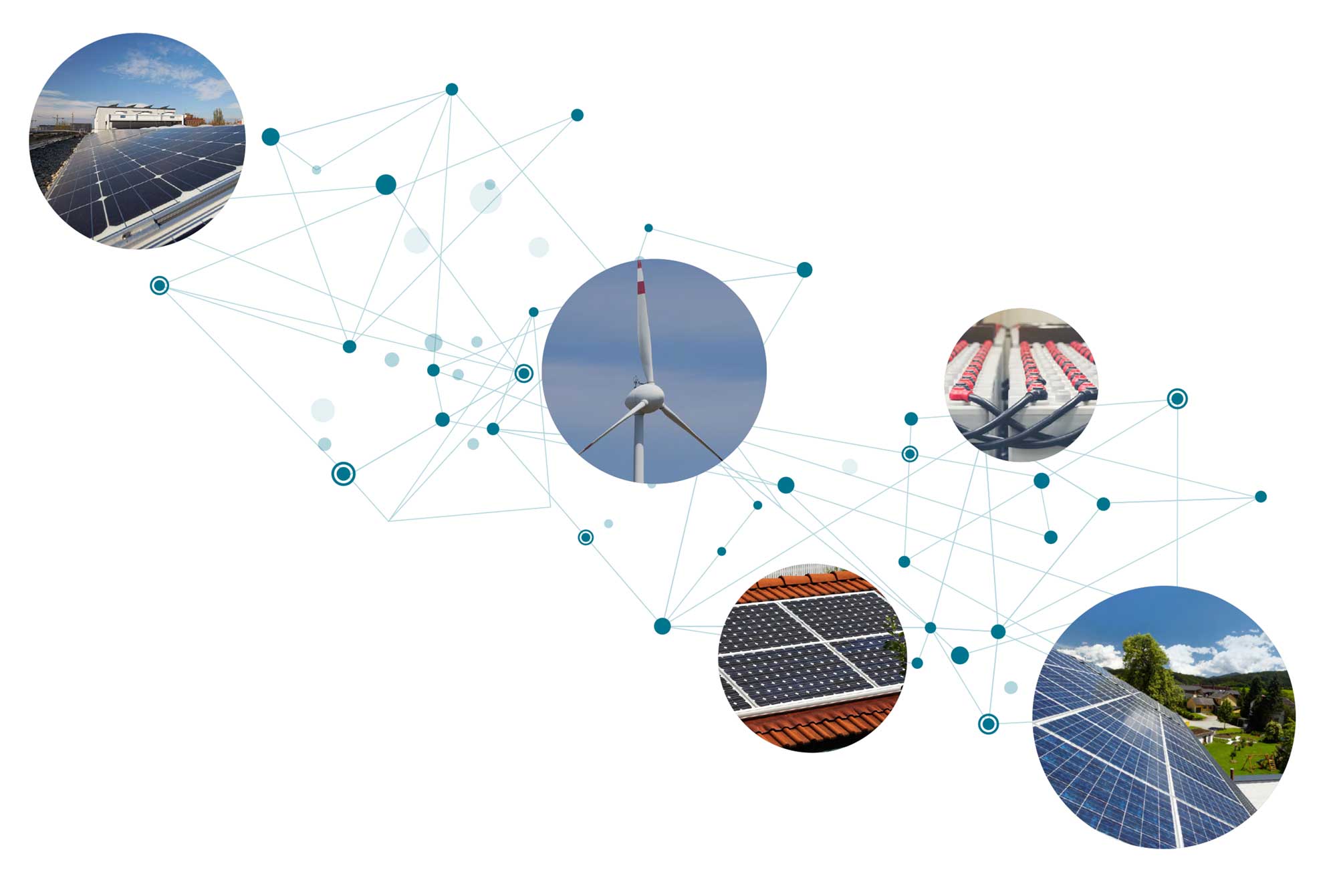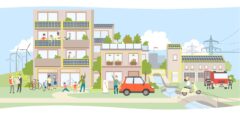Decentralisation, digitalisation and democratisation are essential building blocks to successfully advance the transformation of the energy system towards a climate-neutral energy supply. All three of these aspects come into play in energy communities. Energy communities create new opportunities for citizens to actively participate in the energy transition by collectively producing, consuming and trading energy.
European and national framework conditions
With the “Clean Energy for all Europeans Package” (CEP)1 the European Union has created a legal framework that strengthens the activities and rights of consumers and communities in the energy sector at the local level. The goal is for citizens to be able to get involved in innovative business areas such as peer-to-peer energy trading, energy sharing and flexibility trading in the energy market. They should also benefit financially.
The national climate targets envisage converting Austria’s electricity supply to be 100 per cent electricity from renewable energy sources (national balance) by 2030 and to achieve climate neutrality by 2040. With the Renewable Energies Expansion Act (EAG)2, important european targets were implemented in Austria in 2021. The possibility of establishing energy communities is a central part of this. Energy communities represent a new milestone for the Austrian energy industry. They enable proactive participation in the energy transition, promote the expansion of decentralised energy systems, offer economic incentives and strengthen regional value chains.
Two models for energy communities
The national laws define two energy community models: the renewable energy community (EEG/Erneuerbare Energiegemeinschaft), which is limited to local communities and the citizen energy community (BEG/Bürgerenergiegemeinschaft), which is geographically unrestricted throughout Austria. A renewable energy community (EEG) may jointly generate, store, consume and sell energy (electricity and heat) from renewable sources across property boundaries. Members or shareholders of a renewable energy community can be private or legal entities, local governments, local authorities or even SMEs. The main purpose of a renewable energy community is not financial gain; the focus is on regional benefits and the advantages for the members. In contrast to the renewable energy community, the citizen energy community (BEG) may only generate, store, consume or sell electrical energy. It is not limited to renewable sources and can extend over the concession areas of several grid operators throughout Austria. The members or partners of citizen energy communities can also be private individuals and/or legal entities. Large companies can also participate here, but they are not allowed to exercise any control. It applies in the same way that making a profit should not be the priority.
Since the EAG 2021 was passed, more than 100 energy communities have been founded in Austria. Another 290 EEGs and 10 BEGs are planned (2/2023)
The independent service centre offers all important information, documents and contact addresses on the topic of energy communities on its website. The coordination office works closely with the energy agencies and institutes in the federal states, which offer on-site advice in the region. The offer is constantly being expanded and supplemented with the latest facts, tools and videos.
www.energiegemeinschaften.gv.at

„For energy communities to function optimally, they need suitable energy management systems that efficiently control the generation and consumption of renewable energy, in line with demand. In my opinion, there is still a need for more research here, as well as in the area of load management and in energy storage systems. An important topic, especially for municipalities, is the security of supply. This will require
technical solutions, for example, to be able to operate individual buildings independently in the event of a blackout.”
Eva Dvorak
Head of Austrian Coordination Office for Energy Communities
Innovations for the energy system of tomorrow
In order to spread the idea of energy communities even more broadly, role models and best-practice examples are needed. Research and technology development as well as new digital solutions can help drive the optimisation, further development and successful implementation of energy communities and initiate a new dynamic for the decentralised energy transition. Core technologies for use in energy communities include smart metering and control systems, digital platforms, data management systems and blockchain technologies. In addition to sharing energy, other functionalities for energy communities are increasingly being considered and integrated. RTI projects deal, among other things, with efficient energy management systems, storage technologies, concepts for sector integration (electricity, heat and e-mobility) or the grid-compatible operation of energy communities. By integrating storage systems, the energy community can be made more self-sufficient; at the same time these storage systems serve as security in the event of a blackout. Through the systematic control of generation and consumption, the energy communities can offer flexibilities on the energy market and thus contribute to the system stability of the power grid. Digitalisation is a fundamental prerequisite for this and provides the basis for optimised operation of energy communities and new economically attractive business models.
In this issue we present some RTI projects from Austria that are developing new (digital) technologies, concepts and solutions for energy communities and are thus making a contribution to the successful implementation of the energy transition.
1 energy.ec.europa.eu/topics/energy-strategy/clean-energy-all-europeans-package_en
2 oesterreich.gv.at/Gesetzliche-Neuerungen/archiv-bgbl-2021/eag-paket.htmlen


